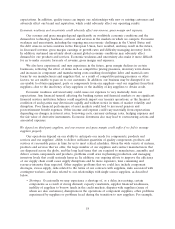HP 2011 Annual Report Download - page 30
Download and view the complete annual report
Please find page 30 of the 2011 HP annual report below. You can navigate through the pages in the report by either clicking on the pages listed below, or by using the keyword search tool below to find specific information within the annual report.basis. In addition, newer geographic markets may be relatively less profitable due to investments
associated with entering those markets and local pricing pressures, and we may have difficulty
establishing and maintaining the operating infrastructure necessary to support the high growth rate
associated with some of those markets. Market trends, competitive pressures, commoditization of
products, seasonal rebates, increased component or shipping costs, regulatory impacts and other factors
may result in reductions in revenue or pressure on gross margins of certain segments in a given period,
which may necessitate adjustments to our operations.
HP’s stock price has historically fluctuated and may continue to fluctuate, which may make future prices of
HP’s stock difficult to predict.
HP’s stock price, like that of other technology companies, can be volatile. Some of the factors that
could affect our stock price are:
• speculation in the media or investment community about, or actual changes in, our business,
strategic position, market share, organizational structure, operations, financial condition,
financial reporting and results, effectiveness of cost-cutting efforts, value or liquidity of our
investments, exposure to market volatility, prospects, business combination or investment
transactions, stock price performance or executive team;
• the announcement of new or planned products, services, technological innovations, acquisitions,
divestitures or other significant transactions by HP or its competitors;
• quarterly increases or decreases in revenue, gross margin, earnings or cash flow from operations,
changes in estimates by the investment community or guidance provided by HP, and variations
between actual and estimated financial results;
• announcements of actual and anticipated financial results by HP’s competitors and other
companies in the IT industry; and
• the timing and amount of share repurchases by HP.
General or industry specific market conditions or stock market performance or domestic or
international macroeconomic and geopolitical factors unrelated to HP’s performance also may affect
the price of HP stock. For these reasons, investors should not rely on recent or historical trends to
predict future stock prices, financial condition, results of operations or cash flows. In addition,
following periods of volatility in a company’s securities, securities class action litigation against a
company is sometimes instituted. If instituted against HP, this type of litigation could result in
substantial costs and the diversion of management time and resources.
Our revenue, cost of sales, and expenses may suffer if we cannot continue to license or enforce the
intellectual property rights on which our businesses depend or if third parties assert that we violate their
intellectual property rights.
We rely upon patent, copyright, trademark and trade secret laws in the United States, similar laws
in other countries, and agreements with our employees, customers, suppliers and other parties, to
establish and maintain intellectual property rights in the products and services we sell, provide or
otherwise use in our operations. However, any of our intellectual property rights could be challenged,
invalidated, infringed or circumvented, or such intellectual property rights may not be sufficient to
permit us to take advantage of current market trends or otherwise to provide competitive advantages,
either of which could result in costly product redesign efforts, discontinuance of certain product
offerings or other competitive harm. Further, the laws of certain countries do not protect proprietary
rights to the same extent as the laws of the United States. Therefore, in certain jurisdictions we may be
unable to protect our proprietary technology adequately against unauthorized third-party copying or
use; this, too, could adversely affect our competitive position.
22
























